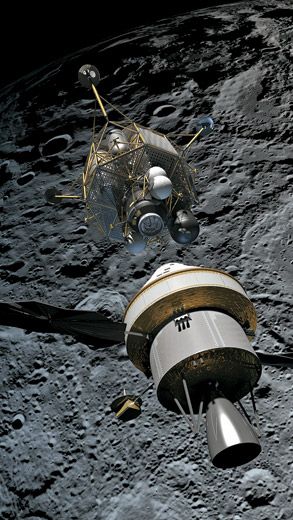Lunar Living
The quest to return to the moon ignites new hope and vision at the 50-year-old space agency
/https://tf-cmsv2-smithsonianmag-media.s3.amazonaws.com/filer/mall_jul08_631.jpg)
The unassuming log cabin has long symbolized the American drive to tame and settle the frontier. But if aerospace engineer Robert Howard Jr., age 36, is successful, 21st-century settlers will live in a dwelling that might resemble an oversized balloon or soup can. As manager of the "habitability design center" at NASA's Johnson Space Center in Houston, Howard is helping to create a dwelling that could comfortably house four people on the moon for at least half a year. He is one of many NASA employees who will be speaking at this year's Smithsonian Folklife Festival (from June 25 to 29 and July 2 to 6, on the National Mall in Washington, D.C.), which will commemorate the space agency's 50th anniversary.
Howard says this is a heady time to be working at NASA. In 2004, President Bush set a goal of sending humans back to the moon by 2020 and eventually on to Mars. The lunar outpost would be a training ground and launchpad for trips to the red planet.
But there are plenty of challenges to overcome first. To camp on the moon, astronauts need to be shielded from solar radiation. In a waterless environment every drop of H2O, including sweat and urine, must be recycled and purified. NASA engineers are sorting through dozens of possible models for the lunar outpost—from horizontal, aluminum cylinders to inflatable structures that are essentially giant, Kevlar-reinforced balloons.
Whether NASA will reach its goal for "boots on the moon" depends on support from future presidents and Congress. In 1989, President George H. W. Bush announced a similar goal of sending people to the moon and on to Mars, but it was scrapped after Congress balked at the high cost.
And some scientists oppose manned missions. Steven Weinberg, a physicist at the University of Texas and a Nobel laureate, says space research generally can be done with robotic probes for a fraction of the cost. "Unmanned missions have been tremendously important in making this a golden age of astronomy," Weinberg says, while manned space exploration "costs hundreds of billions of dollars and doesn't serve any important purpose."
But setting up an outpost on the moon is an essential step toward eventually settling other planets, argues John Logsdon, director of the Space Policy Institute at George Washington University, who will join the Smithsonian Air and Space Museum this fall. "It's not primarily about science," Logsdon says. "It's to test the belief that humans are destined to live in other places except earth."
Howard echoes that sentiment. "Space symbolizes freedom and opportunity," says the NASA lunar architect, who was an avid Star Trek fan at age 3. "There is an entire universe out there for you to explore... I call it 'space, the unlimited frontier.'"



